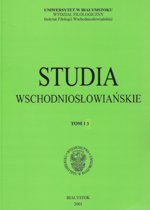Демонологический дискурс в произведении Ореста Сомова "Оборотень" как проявление общеславянской культурной традиции
Demonological discourse in Orest Somov’s “The Werewolf” (“Оборотень”) as a manifestation of Pan-Slavic cultural tradition
Author(s): Magdalena Kałuża Subject(s): Language studies, Language and Literature Studies, Literary Texts, Russian Literature
Published by: Wydawnictwo Uniwersytetu w Białymstoku
Keywords: Сомов; оборотень; колдун; дискурс; демонология
Summary/Abstract: The article analyses demonological motifs in the artistic structure of Orest Somov’s “The Werewolf” (“Оборотень”) evoked by the image of the sorcerer Ermolai who transforms into a werewolf, and his foster son Artiom – a profane who repeats the sorcerer’s acts and becomes initiated into adulthood as he changes into a werewolf himself. The author also considers the image of Akulina, Artiom’s fianc´e, and the collective character – the village people. The motifs are studied from the perspective of discourse construed as the way of using language, communicating ideas and social interaction. The author points out differences between characters’ and narrator’s points of view in the context of author’s concept of the world, Romantic folklore theory and Slavic folklore. Discourse analysis allowed the author not only to outline individual qualities of characters, but also to show their relationships with different socio-cultural groups: neighbourhood, religious, folk and national communities.
Journal: Studia Wschodniosłowiańskie
- Issue Year: 2015
- Issue No: 15
- Page Range: 39-52
- Page Count: 14
- Language: Russian

